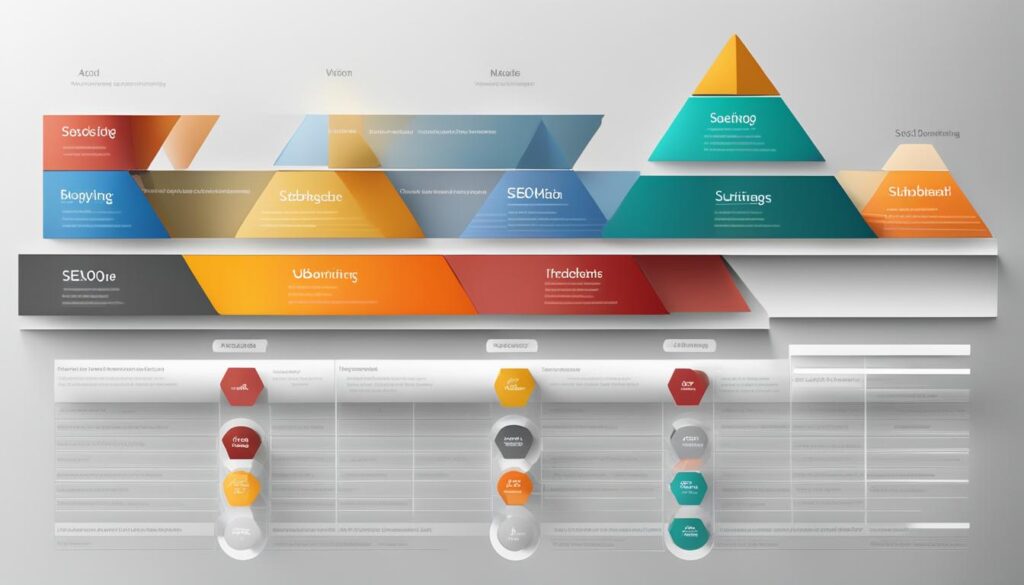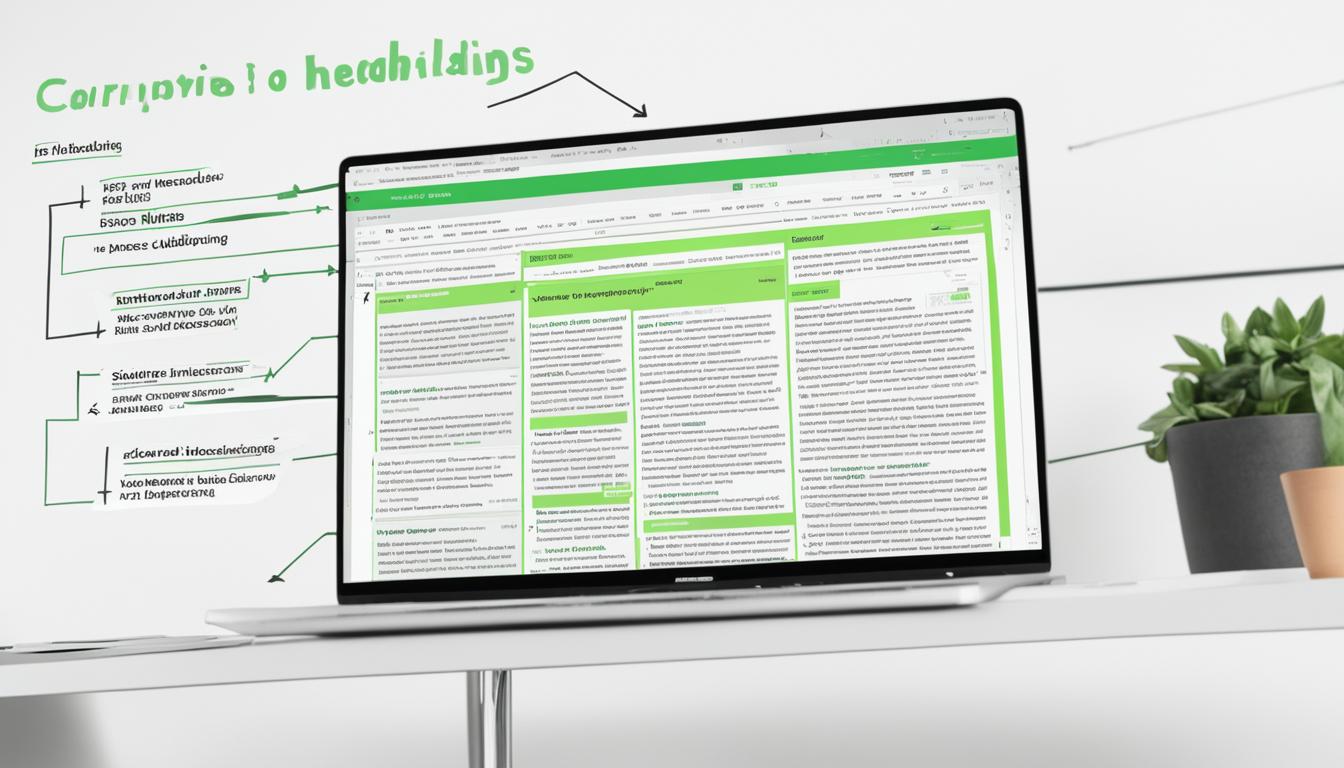Hey there, fellow content creators and SEO enthusiasts! Today, I want to talk about the importance of optimizing headings and subheadings for SEO and share some valuable tips on how to make your content more search engine-friendly. So, let’s dive right in!
When it comes to creating online content, you want to make sure it’s not only informative and engaging but also optimized for search engines. That’s where headings and subheadings come into play. These header tags, such as H1, H2, and H3, provide structure and context to your webpages, helping both users and search engines understand the content more efficiently.
By incorporating relevant keywords into your headings and subheadings in a natural and user-friendly manner, you can boost your content’s search visibility and increase your chances of ranking higher in search engine results.
But how do you optimize your headings and subheadings effectively? Here are some tried-and-true best practices:
- Use header tags to provide clear structure and hierarchy to your content.
- Break up long blocks of text with subheadings to improve readability and scannability.
- Include relevant keywords naturally in your headers for better SEO optimization.
- Optimize your header tags to match popular search queries and enhance your chances of appearing in featured snippets.
- Stick to using only one H1 tag per page to maintain organized content.
- Keep your header tags consistent in format and length throughout your website for better user experience.
- Write compelling and interesting headers that engage readers and encourage them to continue reading.
By following these tips and implementing them in your content creation strategy, you can optimize your headings and subheadings effectively, making your content more readable for users and improving its performance in search engine rankings. So, let your headings shine and watch your organic traffic soar!
Key Takeaways:
- Optimizing headings and subheadings is crucial for improving your content’s search visibility.
- Use header tags to provide structure and hierarchy to your content.
- Break up long blocks of text with subheadings for better readability.
- Include relevant keywords naturally in your headers to boost SEO optimization.
- Write engaging and compelling headers to keep readers hooked.
The Importance of Header Tags in SEO
Header tags are an essential component of search engine optimization (SEO) strategies. They play a significant role in improving the visibility and ranking of your website in search engine results. Header tags, such as H1, H2, and H3, provide structure and hierarchy to your content, making it easier for both search engines and users to understand the information presented.
One of the primary benefits of using header tags is their ability to communicate the relevance and context of your content to search engines. When you include relevant keywords in your header tags, search engines can better understand the main topics discussed on your webpages. This helps search engines categorize and index your content, increasing the chances of it being displayed in relevant search results.
Furthermore, header tags enhance the user experience by improving the readability and scannability of your content. Users can quickly glance at the headings to get an overview of the information covered in the text. This structure makes it easier for users to navigate through your content and find the specific information they are looking for.
Properly optimized header tags can also contribute to increased organic search visibility. When search engines recognize the relevance and hierarchy of your header tags, they are more likely to feature your website in prominent positions in search results. This increased visibility can drive more organic traffic to your website and potentially result in higher conversion rates.
Key Benefits of Header Tags in SEO:
- Improved search engine visibility
- Enhanced user experience and readability
- Clear communication of content relevance to search engines
- Potential for higher organic traffic and conversions
By prioritizing the use of header tags and following SEO best practices, you can optimize your website’s visibility and attract valuable organic traffic. Incorporating relevant keywords, maintaining proper hierarchy, and ensuring consistency in your header tags are key strategies for leveraging the importance of header tags in SEO.
| Header Tag | Significance |
|---|---|
| H1 | The main title of the webpage. It should accurately describe the content. |
| H2 | Subheadings that provide a clear structure and highlight important sections. |
| H3 | Further subheadings that break down the content into more specific sections. |
Best Practices for Header Tag Optimization

When it comes to optimizing header tags for SEO, it’s important to follow the best practices that help improve search visibility and enhance the user experience. Here are some tips for effectively optimizing your header tags:
1. Use header tags to provide structure
Each header tag, such as H1, H2, or H3, should give a clear idea of the information covered in the following text. This helps both users and search engines understand the content’s hierarchy and organization.
2. Break up blocks of text with subheadings
Scannable articles that are easy to read perform better in search engines. Breaking up your content with subheadings not only improves readability but also provides visual breaks for users. This encourages them to continue reading and enhances the overall user experience.
3. Include relevant keywords in header tags
Using relevant keywords naturally in your header tags provides context to search engines. Incorporate keywords that accurately represent the content while maintaining a natural flow. Avoid over-optimization, as it can negatively impact user experience and search rankings.
4. Optimize for featured snippets
Structured header tags that match popular search queries increase the chances of your content appearing in featured snippets. Featured snippets are highly visible and can drive additional organic traffic to your website. Consider formatting your header tags in a way that answers commonly asked questions or provides concise summaries of the content.
5. Use only one H1 tag
Using multiple H1 tags can make your content look disorganized, confusing both users and search engines. Stick to one H1 tag for the main title or heading of your page. Utilize H2, H3, and subsequent header tags for subheadings and additional sections.
6. Keep your header tags consistent
Maintaining a consistent format and length for your header tags throughout your website helps establish a clear and cohesive structure. Consistency improves user experience and makes it easier for search engines to crawl and understand your content.
7. Make your header tags interesting
Write compelling headers that engage readers and encourage them to continue reading. Use header tags to create curiosity, highlight key points, or introduce new sections. Interesting headers not only improve the user experience but also increase the likelihood of users sharing and linking to your content.
By implementing these best practices for header tag optimization, you can effectively improve the structure, readability, and search visibility of your content. Remember to use relevant keywords naturally, break up text with subheadings, and maintain consistency throughout your website. Engaging and informative header tags play a vital role in attracting more organic traffic and enhancing the overall SEO performance of your website.
Effective Use of Subheadings in SEO

Subheadings in SEO are like road signs that guide readers through the content and help search engines understand the structure of your webpage. They play a crucial role in organizing information, improving readability, and enhancing the user experience. By leveraging subheadings effectively, you can optimize your content for both human readers and search engines.
The Importance of Subheadings in SEO
Subheadings are essential for SEO because they:
- Improve scannability: Subheadings break up the content into smaller, easily digestible sections, making it easier for readers to skim through and find the information they need.
- Enhance readability: Well-structured subheadings improve the flow of the text and help readers understand the main points of each section.
- Aid in information organization: Subheadings provide a logical structure to your content, making it more organized and coherent.
- Facilitate keyword optimization: Including relevant keywords in subheadings helps search engines identify the context and relevance of your content.
Overall, using subheadings effectively can improve the user experience, engage readers, and increase the chances of your content ranking higher in search engine results.
Subheading Optimization Tips
To optimize your subheadings for SEO, consider the following tips:
- Use descriptive and concise subheadings: Clearly communicate the main idea of each section using keywords and relevant phrases.
- Follow a hierarchy: Use H2 tags for main subheadings, and if necessary, use H3 tags for further subcategorization.
- Keep consistency: Maintain a consistent formatting style for your subheadings throughout the content.
- Avoid excessive keyword optimization: While it’s important to include keywords, ensure that they are used naturally and in a way that enhances the readability of the content.
- Make subheadings engaging: Use compelling language and incorporate questions or statements that pique readers’ curiosity.
By following these subheading optimization tips, you can create content that is both user-friendly and search engine-friendly, maximizing your chances of ranking higher in organic search results.
Conclusion
In conclusion, optimizing headings and subheadings is crucial for SEO success. The proper use of header tags provides structure and context, making your content more readable and visible to search engines. By following best practices such as creating a clear structure, utilizing subheadings, and incorporating relevant keywords, you can enhance your content’s performance in search engine rankings.
Remember to maintain consistency in your header tags throughout your website, using them strategically to break up text and engage readers. Make your headers compelling and interesting to encourage users to continue reading. With effective heading and subheading optimization, you can significantly improve your website’s SEO and attract organic traffic.
In summary, optimizing headings and subheadings involves structuring your content, providing scannable articles, and using keywords naturally. By following these key takeaways, you can maximize the impact of your header tags and improve your website’s search visibility:
- Create a clear structure with proper use of header tags.
- Break up text with subheadings for improved readability.
- Incorporate relevant keywords in your headers.
- Optimize for featured snippets to increase visibility.
- Use only one H1 tag and keep header tags consistent.
- Write engaging headers that captivate readers.
By implementing these techniques, you can optimize your headings and subheadings effectively and boost your website’s SEO performance.










